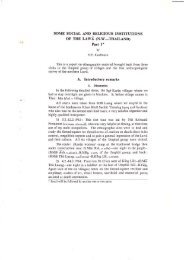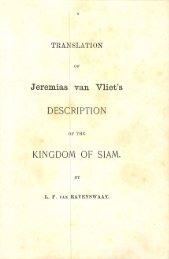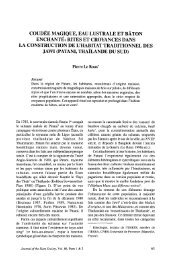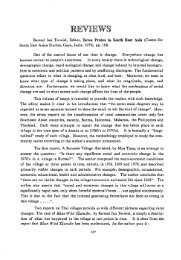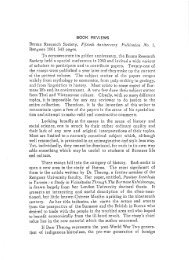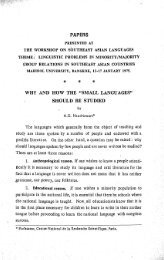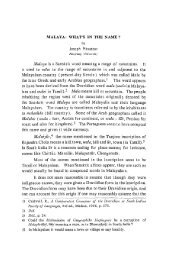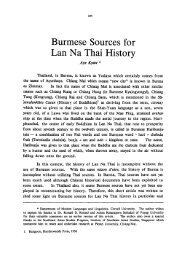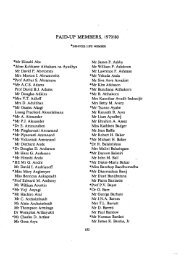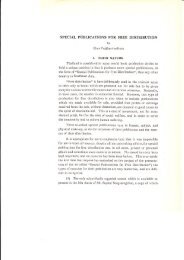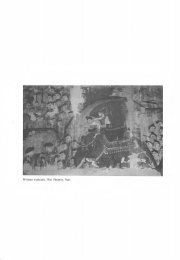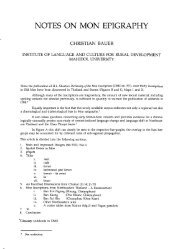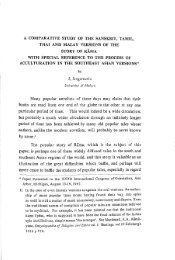funerary rites and the buddhist meaning of death - Siamese Heritage ...
funerary rites and the buddhist meaning of death - Siamese Heritage ...
funerary rites and the buddhist meaning of death - Siamese Heritage ...
Create successful ePaper yourself
Turn your PDF publications into a flip-book with our unique Google optimized e-Paper software.
2 Phra Khru Anusaraf!asasanakiarti & Charles F. Keyes<br />
concerning <strong>the</strong> deeper dharmic <strong>meaning</strong>s <strong>of</strong> aspects <strong>of</strong> <strong>the</strong> human condition. Relatively<br />
rarely, although increasingly more common, a monk has put his religious exegesis <strong>of</strong> ritual<br />
into writing, <strong>the</strong>reby making it available for o<strong>the</strong>rs to read or to use as a sermon. Whatever<br />
<strong>the</strong> form might be, it has been <strong>the</strong> responsibility <strong>of</strong> monks from <strong>the</strong> earliest days <strong>of</strong> Buddhism<br />
to provide o<strong>the</strong>rs with religious - that is, dharmic - <strong>meaning</strong>s for <strong>the</strong> elements <strong>of</strong> <strong>the</strong><br />
rituals which punctuate <strong>the</strong> process <strong>of</strong> human life.<br />
This responsibility has led many monks to attend to <strong>the</strong> form as. well as to <strong>the</strong> content<br />
<strong>of</strong> rituals. Indeed, in any Buddhist community it is always <strong>the</strong> monk (or ex-monk) who has<br />
spent- many years in <strong>the</strong> Order who is <strong>the</strong> most knowledgeable regarding <strong>the</strong> traditional as<br />
well as <strong>the</strong> essential (as prescribed by scriptural authority) elements <strong>of</strong> ritual. Again, this<br />
knowledge has been communicated to o<strong>the</strong>rs mainly by word <strong>of</strong> mouth; however, a few monks<br />
have composed written guides to <strong>the</strong> procedure <strong>of</strong> <strong>the</strong> rituals performed within <strong>the</strong>ir<br />
communities.<br />
The text which I have translated here combines both an account <strong>of</strong> ritual procedure -<br />
in this case, <strong>of</strong> <strong>the</strong> forms <strong>of</strong> rituals connected with <strong>death</strong> as <strong>the</strong>y are carried out in <strong>the</strong> community<br />
<strong>of</strong> Mae Sariang in nor<strong>the</strong>rn Thail<strong>and</strong> - with a dharmic interpretation <strong>of</strong> this procedure.<br />
This text is unusual in that it was not composed for <strong>the</strong> benefit <strong>of</strong> practising Buddhists in<br />
Mae Sariang, but for <strong>the</strong> purpose <strong>of</strong> providing a foreign ethnographer - myself- with some<br />
depth <strong>of</strong> underst<strong>and</strong>ing <strong>of</strong> <strong>death</strong> rituals which I had observed while engaged in research in<br />
Mae Sariang.<br />
I spent nearly 18 months in Mae Sariang during 1967-1968, engaged in a study <strong>of</strong> <strong>the</strong><br />
religious life <strong>of</strong> nor<strong>the</strong>rn Thai Buddhists living in Mae Sariang town as well as o<strong>the</strong>r aspects<br />
<strong>of</strong> culture <strong>and</strong> society in Mae Sariang District. 1 I was extraordinarily fortunate in my work<br />
on Buddhist practice to gain not only <strong>the</strong> approval <strong>of</strong> Phra Khrii AnusaraQasasanakiarti,<br />
<strong>the</strong> district ecclesiastical head <strong>of</strong> Mae Sariang District, but also his active involvement in<br />
my undertaking. To this day he maintains an abiding interest in <strong>the</strong> culture <strong>of</strong> his native place,<br />
<strong>and</strong> pursues this interest with intellectual inquisitiveness. On many occasions, I discovered<br />
that my naive queries as to <strong>the</strong> nature <strong>of</strong> some practice served to stimulate him to provide<br />
me with a detailed <strong>and</strong> systematic account. Towards <strong>the</strong> end <strong>of</strong> my stay in Mae Sariang, he<br />
prepared, at my behest, a set <strong>of</strong> detailed notes on many <strong>of</strong> <strong>the</strong> ritual practices which I had<br />
observed. The record <strong>of</strong> customs associated with <strong>death</strong> which is presented here was originally<br />
written on 2 November 1968.<br />
In <strong>the</strong> intervening decade, I have not had <strong>the</strong> time to return to this text, being concerned<br />
with o<strong>the</strong>r work growing out <strong>of</strong> my research in Mae Sariang, as well as o<strong>the</strong>r research in<br />
nor<strong>the</strong>astern Thail<strong>and</strong> <strong>and</strong> in Chiang Mai. Only within <strong>the</strong> past year have I begun to focus<br />
once more on <strong>the</strong> rituals which I observed in Mae Sariang. 2 Specifically, I have devoted my<br />
attention primarily to those rituals connected with ordination into <strong>the</strong> Buddhist monkhood<br />
1. My research was carried out with support from <strong>the</strong> National Science Foundation <strong>and</strong> <strong>the</strong> University<br />
<strong>of</strong> Washington.<br />
2. I am grateful for support, which has made my new work possible, granted by <strong>the</strong> Graduate School<br />
Research Fund <strong>of</strong> <strong>the</strong> University <strong>of</strong> Washington <strong>and</strong> <strong>the</strong> Social Science Research Council. I am also<br />
indebted to <strong>the</strong> University <strong>of</strong> Washington for giving me time during. a sabbatical leave to carry out this work.



